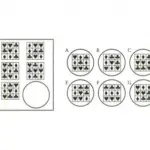
Adolescence is, for the vast majority, a critical moment in our lives. It is the moment when you should think about what you want to be when you grow up, given that in two or three years you will have to make an (almost) definitive decision.
Although everyone has life aspirations, sometimes it is very difficult to decide. That is why there are tests that allow us to guide ourselves professionally, one of them being the General Aptitude Test Battery.
This instrument has proven useful in helping those people who still do not know what to do with their lives and, depending on their strengths, it allows them to give advice. Let’s take a closer look at how it does it.
General Aptitude Test Battery What is it?
The General Aptitude Test Battery (GATB) is a questionnaire that measures people’s skills And, depending on what you are best at, it is recommended to train in one type of profession or another. This type of tests are used in the field of career guidance, being especially useful for adolescents who have not yet decided on their professional future.
The most modern version of this questionnaire includes 12 subtests, which measure 9 factors or aptitudes. These subtests are: name comparison, calculation speed, three-dimensional space, vocabulary, tool comparison, arithmetic reasoning, shape comparison, scratching, peg placement, peg turning, assembly and disassembly.
According to the model behind this battery of tests, the idea of aptitude is something you have innately. That is to say, although education can increase knowledge through learning content, people, already from birth, are more skilled in tasks that are related to one aspect or another. The General Aptitude Test Battery, with this in mind, measures what people are good at, regardless of how much they know.
For example, if this battery of tests is administered to a subject and it is seen that he or she has high scores on tests that measure numerical aptitude, it can be understood that the person will be good in disciplines such as mathematics, physics, and mathematics. chemistry. It is possible that he has not done anything related to these subjects for years, but the fact that he has numerical aptitudes indicates that it will be very easy for him, instinctively, to understand these disciplines.
Historical background
The origins of these tests date back to the last century, during the Second World War. The USES (United States Employment Service) dedicated itself to building nearly 100 tests whose purpose was to measure different aptitudes that seemed to be related to the degree of success in some professions. These first tests took into account aspects such as arithmetic, vocabulary, orientation in space…
After carrying out several studies and evaluating the data obtained, Through factor analysis, up to 9 independent factors were established, each of them related to various professions. Subsequently, perfecting both the test items and their design, the final version of the General Aptitude Test Battery was prepared.
This instrument already represented a great advance at the time, given that allowed people to be guided based on their strengths in a relatively short period of time, about two and a half hours. It is for this reason that this questionnaire has been widely used since 1945.
What skills do these tests measure?
As already mentioned, the origins of this instrument date back to the last century and, when the definitive version was obtained after using factor analysis, the following 9 skills were established.
1. General intelligence (G)
It is understood by general intelligence the ability to learn anything in any context. That is, having the ability to grasp or understand fundamental instructions and principles.
Within this skill would be the ability to reason and make judgments.
2. Verbal (V)
Verbal aptitude is the ability to understand the meaning of words and make appropriate use of them.
This ability is fundamental for language, both when formulating it, orally or in writing, and understanding the relationships between words that one listens to or reads.
3. Numeric (N)
Ability to perform arithmetic type operations quickly and safely. It is a basic aptitude to be able to properly understand mathematics and other disciplines in which numerical symbols are used.
4. Space (S)
Spatial aptitude refers to the ability to visualize geometric shapes and be able to understand their representation both dimensionally and three-dimensionally.
It is also important to recognize the relationship between an object and its movement in space.
5. Perception of shapes (P)
Shape perception is related to being able to perceive details of objects, in addition to being able to make visual comparisons between objects and observe small differences in terms of shape, shading, length, width…
6. Office Perception (Q)
The perception of office refers to the ability to perceive verbal and numerical details observing important differences in the content or errors that must be corrected.
7. Motor coordination (K)
Ability to coordinate the movement of the eyes with that of the limbs, hands and fingers. Ability to execute safe and precise movements
8. Manual dexterity (M)
Ability to handle hands with ease and dexterity, performing movements such as placing objects or rotating them precisely.
9. Digital dexterity (F)
Ability to handle small objects with fingers, quickly and safely.
What uses does it have?
There are several uses that can be made of this questionnaire, although it should be noted that all of them are related to the world of work. Usually used to guide adolescents who, at the end of their compulsory studies, do not know what to continue studying or what to dedicate themselves to, this tool being a clue to where they could dedicate themselves.
General intelligence aptitude, being an indicator of the person’s ability to learn regardless of the context and content, can be used when determining whether an adolescent should continue with studies after finishing high school or should choose to train for jobs. that require less studies. Tests that address verbal and numerical aptitude also serve as useful indicators for this purpose.
However, if the person has already decided to study something after completing the compulsory education cycle, this questionnaire can be used to help them choose a specific field or profession.
However, it is not only useful for those people who have not yet studied a degree. It is also used to select those employees who have the most suitable skills for the type of work for which they ask to be hired or, once inside the company, it serves to place them in departments where they can excel in a certain skill.
For example, if you are looking for a job in a factory, it is expected that the employer will look for candidates who have skills related to the handling of machinery, such as motor coordination, manual dexterity and digital dexterity.
critics
As with virtually any test, the General Aptitude Test Battery is not without its critics. The subtests that make it up, especially those that measure perceptual aspects, seem to do not have sufficient construct validity, in terms of convergent validity. However, it should be noted that the subtests that are dedicated to measuring more cognitive aspects are solidly valid.
Another criticism that has been the subject of is related to the pillar of this questionnaire: skills. Some researchers maintain that the aptitudes proposed in the general battery of aptitude tests are too correlated, which could mean that what the different subtests of this instrument measure are the same.
Finally, one of the criticisms it has received is related to the race of the subjects in the United States. It has been seen that white people obtained much higher scores than African-American people, probably because the questionnaire is not free of items that have been formulated in a way that is not independent of the culture of these two ethnic groups.








